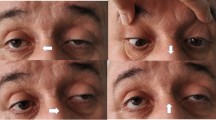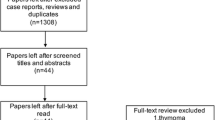Opinion statement
Treatment decisions for ocular myasthenia gravis (OMG) should be based on symptomatology. Local, nonpharmacologic treatment of ptosis or diplopia is successful in relatively few patients, and the majority of patients require drug therapy for satisfactory resolution of their symptoms. Response to anticholinesterase agents is variable, but should always be used as the first-line agent or adjunctive therapy in the treatment of OMG. It is unknown whether early treatment of OMG with corticosteroids or other immunosuppressive agents prevents or delays the development of generalized myasthenia, although some observations support this speculation. Corticosteroids are usually necessary for adequate improvement of ophthalmoplegia or ptosis. Surgical correction of ptosis or ocular motility deficits is not recommended for most patients with OMG, because of the fluctuating nature of the deficits and the high rate of recurrent deficits following surgery. All patients with OMG should be screened for the presence of thymus tumors, and thymectomy is recommended for all patients with a thymoma. Some patients with OMG who do not harbor a thymus tumor may also benefit from thymectomy.
Similar content being viewed by others
References and Recommended Reading
Grob D, Arsura EL, Brunner NG, Nambe T: The course of myasthenia gravis and therapies affecting outcome. Ann N Y Acad Sci 1987, 505:472–499.
Bever CT, Aquino AV, Penn AS, et al.: Prognosis of ocular myasthenia. Ann Neurol 1983, 14:516–519.
Simpson JF, Westerberg MR, Magee KR: Myasthenia gravis: an analysis of 295 cases. Acta Neurol Scand 1966, 42(suppl):6–19.
Drachman DB: Myasthenia gravis. N Engl J Med 1994, 330:1797–1810.
Liu GT, Volpe NJ, Galetta SL: Eyelid and facial nerve disorders. In Neuro-ophthalmology: diagnosis and management. Philadelphia: WB Saunders Company; 2001:464–512.
Sanders DB, Howard JF: AAEE minimonography #25: single-fiber electromyography in myasthenia gravis. Muscle Nerve 1986, 9:808–819.
Kelly JJ, Daube JR, Lennon VA, et al.: The laboratory diagnosis of mild myasthenia gravis. Ann Neurol 1982, 12:238–242.
Rivero A, Crovetto L, Lopex L, et al.: Single fiber electromyography of extraocular muscles: a sensitive method for the diagnosis of ocular myasthenia gravis. Muscle Nerve 1995, 18:943–947.
Grob D, Brunner NG, Namba T: The natural course of myasthenia gravis and effect of therapeutic measures. Ann N Y Acad Sci 1981, 377:652–669.
Fischer KC, Schwartzman RJ: Oral corticosteroids in the treatment of ocular myasthenia gravis. Ann N Y Acad Sci 1976, 274:652–658.
Kuppersmith MJ, Moster M, Bhuiyan S, et al.: Beneficial effects of corticosteroids on ocular myasthenia gravis. Arch Neurol 1996, 53:802–804.
Sommer N, Sigg B, Melms A, et al.: Ocular myasthenia gravis: response to long term immunosuppressive treatment. J Neurol Neurosurg Psychiatry 1997, 62:156–162. Retrospective review 78 patients with OMG. Fifty patients were treated with prednisone or azathioprine. Only 12% of patients treated with an immunosuppressive agent developed generalized myasthenia versus 64% of patients not treated with immunosuppressive agent during a 2 to 4 year follow-up.
Weinberg DH, Rizzo JF, Hayes MT, et al.: Ocular myasthenia gravis: predictive value of single-fiber electromyography. Muscle Nerve 1999, 22:1222–1227. These authors performed a prospective study of 39 patients with OMG and reported the association of a normal SFEMG with myasthenia remaining restricted to the ocular muscles. 82% of patients with a normal SFEMG did not develop GMG after a minimum 2-year follow-up. However, an abnormal SFEMG was not predictive of progression to GMG; only 58% of patients with an abnormal SFEMG developed GMG during the follow-up period.
Myopathies and disorders of neuromuscular transmission. In Walsh and Hoyt’s Clinical Neuro-Ophthalmology, edn 5. Edited by Miller NJ, Newman N. Baltimore: Williams and Wilkins; 1998:1351-1460.
Jaretzki A: Thymectomy for myasthenia gravis: analysis of the controversies regarding technique and results. Neurology 1997, 48(suppl):52–63.
Schumm F, Wierholter H, Gateh-Maoghadam A, Dichgans J: Thymectomy in patients with pure ocular myasthenia. J Neurol Neurosurg Psychiatry 1985, 48:332–337.
Wolfe GI, Barohn RJ, Galetta SL: Drugs for the diagnosis and treatment of myasthenia gravis. In Textbook of Ocular Pharmacology. Edited by Zimmeran TJ. Philadelphia: Lippincott-Raven Publishers; 1997:837–848.
Author information
Authors and Affiliations
Rights and permissions
About this article
Cite this article
Pelak, V.S., Galetta, S.L. Ocular myasthenia gravis. Curr Treat Options Neurol 3, 367–376 (2001). https://doi.org/10.1007/s11940-001-0040-7
Issue Date:
DOI: https://doi.org/10.1007/s11940-001-0040-7




